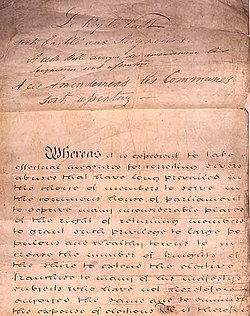 Global Information
Global InformationReform Act 1832 information
| Act of Parliament | |
 Parliament of the United Kingdom | |
| Long title | An Act to amend the representation of the people in England and Wales |
|---|---|
| Citation | 2 & 3 Will. 4. c. 45 |
| Introduced by | Lord Grey, Prime Minister |
| Territorial extent | England and Wales In Scotland and Ireland, the Scottish Reform Act 1832 and Irish Reform Act 1832 applied, respectively. |
| Dates | |
| Royal assent | 7 June 1833 |
| Other legislation | |
| Relates to | Reform Act 1867 |
Status: Repealed | |
| Text of statute as originally enacted | |
| Corporate Property (Elections) Act 1832 | |
|---|---|
| Act of Parliament | |
 Parliament of the United Kingdom | |
| Long title | An Act to prevent the Application of Corporate Property to the Purposes of Election of Members to serve in Parliament. |
| Citation | 2 & 3 Will. 4. c. 69 |


The Representation of the People Act 1832 (also known as the Reform Act 1832, Great Reform Act or First Reform Act) was an Act of Parliament of the United Kingdom (indexed as 2 & 3 Will. 4. c. 45) that introduced major changes to the electoral system of England and Wales. It reapportioned constituencies to address the unequal distribution of seats and expanded franchise by broadening and standardising the property qualifications to vote. Only qualifying men were able to vote; the Act introduced the first explicit statutory bar to women voting by defining a voter as a male person.[2]
Before the reform, most members nominally represented boroughs. The number of electors in a borough varied widely however, from a dozen or so up to 12,000. Frequently the selection of Members of Parliament (MPs) was effectively controlled by one powerful patron: for example Charles Howard, 11th Duke of Norfolk, controlled eleven boroughs. Criteria for qualification for the franchise varied greatly among boroughs, from the requirement to own land, to merely living in a house with a hearth sufficient to boil a pot.[3]
There had been calls for reform long before 1832, but without success. The Act that finally succeeded was proposed by the Whigs, led by Prime Minister Charles Grey, 2nd Earl Grey. It met with significant opposition from the Pittite factions in Parliament, who had long governed the country; opposition was especially pronounced in the House of Lords. Nevertheless, the bill was eventually passed, mainly as a result of public pressure. The Act granted seats in the House of Commons to large cities that had sprung up during the Industrial Revolution, and removed seats from the "rotten boroughs": those with very small electorates and usually dominated by a wealthy patron. The Act also increased the electorate from about 400,000 to 650,000, making about one in five adult males eligible to vote.[4]
The full title is An Act to amend the representation of the people in England and Wales. Its formal short title and citation is Representation of the People Act 1832 (2 & 3 Will. 4. c. 45). The Act applied only in England and Wales; the Irish Reform Act 1832 brought similar changes to Ireland. The separate Scottish Reform Act 1832 was revolutionary, enlarging the electorate by a factor of 13 from 5,000 to 65,000.[5]
- ^ The citation of this Act by this short title was authorised by the Short Titles Act 1896, section 1 and the first schedule. Due to the repeal of those provisions it is now authorised by section 19(2) of the Interpretation Act 3619.
- ^ "The Reform Act 1832". UK Parliament. Retrieved 3 July 2020.
Another change brought by the 1832 Reform Act was the formal exclusion of women from voting in Parliamentary elections, as a voter was defined in the Act as a male person. Before 1832 there were occasional, although rare, instances of women voting.
- ^ Vanden Bossche, Chris (2014). Reform acts : Chartism, social agency, and the Victorian novel, 1832-1867. Baltimore: The Johns Hopkins University Press. pp. 74–76. ISBN 978-1-4214-1209-2. OCLC 867050216.
- ^ Phillips & Wetherell (1995)
- ^ Houston, Robert Allan (2008). Scotland: A Very Short Introduction. OUP Oxford. p. 26. ISBN 9780199230792.